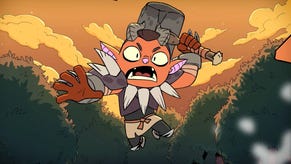The Witcher 3 and Destiny: two different case studies in post-launch support
The Witcher 3 and Destiny have both continued evolving after launch. How have the two projects differed in their approach?
We're lucky to live in a connected age, where post-launch support is an accepted and expected business practice. Games no longer persist in an unbalanced or bug-raddled state; publishers and developers set aside resources to address the inevitable issues that only arise after a game gets into the hands of potentially millions of players.
We're also unlucky to live in a connected age, where post-launch support can be used to justify shipping in an unacceptable state, either due to a lack of appropriate wide-scale beta testing or even in wilful defiance of issues raised by QA teams (those under-appreciated, much-derided and usually powerless guardians of release build quality).
In recent years we've seen several high profile examples of frankly unacceptable release builds, and if key developers and publishers don't raise the bar again we run the risk of a crisis of consumer faith. (Last time that happened, the whole industry crashed. I wonder if Nintendo could save us a second time?)
But I'm not here to froth on about developers and publishers, although that's probably worth doing. Nobody wants to pay $60 or equivalent for something they can't play on launch day, but except in the most egregious cases (Diablo 3, Halo: The Master Chief Collection, Driveclub, Batman: Arkham Knight on PC) release day horrors are usually just that - confined to that initial 24 hours. Some rapid propping up of servers, a quick and dirty patch, and Bob's your uncle. This isn't ideal, maybe, but given the scope and complexity of triple-A development, it's a small miracle.
What I'm interested in is the different ways developers and publishers approach post-launch support, and how that support is perceived. I've picked two very different games I'm pretty familiar with - Destiny and The Witcher 3: Wild Hunt - and looked back over their post-launch support approaches.
Destiny
Destiny is an always-on connected experience. Although you can enjoy much of it in single-player, it's been designed as a multiplayer experience and all the core activities are about playing with others.
To my mind, this game design demands three main pillars of post launch support: network, game experience and ongoing content. Let's talk about each in turn.
Destiny - network support
Years before Destiny went gold, Bungie and Activision had to have been thinking about network support. Shared worlds, instances, matchmaking - all of that runs on infrastructure the developer and publisher would have been beavering away at for donkey's before launch.
If you've grown up with multiplayer games and MMOs you might not be aware of just how much of what's going on in Destiny is happening online. It's not just that your characters and progression are all saved on the cloud; every action you take has to be processed centrally and sent out to nearby players. That Destiny works as well as it does is astonishing, and a large part of the reason why we saw industry insiders tip it so heavily in 2014 game of the year awards, I suspect.
Most of the time we don't think about this at all; it's only when things go wrong that we tend to pay attention. Destiny had significant network issues at launch, and not just due to demand; the network simply wouldn't play nicely with all sorts of common scenarios like academic dormitory WiFi. Most of us were online and shooting face within 24 hours, but for some, the frustration lasted up to a month. Bungie was communicative and responsive, though, and the incident has largely faded from memory.
In ongoing network support, Bungie has been admirably vigilant. The occasional patches of network issues are rare enough that their occurrence is a talking point, and maintenance outages are remarkably few and well-spaced out.
The developer hasn't been as successful in squashing lag, and especially those who use it to their advantage in PvP. This is definitely an area in which Bungie could stand to up its game.
Destiny - game experience
Destiny is a remarkably smooth experience, given how many different irons it has in the fire. Perhaps that's why Bungie has been very conservative to date in fiddling with it.
Destiny does have balance problems, and Bungie has been slow to address them. To date it has made only a couple of balance changes to weapons, for example, despite an obvious need for tuning - and we have to wait till September for the next batch. It wasn't until April - seven months after launch - that Strike balance was adjusted.
If you're a big fan of how the game plays at present you might argue that Bungie leaves well enough alone because it has got it right already, and that's certainly a valid perspective. But beyond balance, Bungie hasn't been as responsive as players would like in squashing bugs - especially in the game's raids. These multiplayer set-pieces were the end-game and best source of equipment before House of Wolves launched, and the turn around on fixes was painfully slow.
Destiny - ongoing content
This ties in a bit with general game experience. Destiny suffers a bit from comparison to early descriptions of the project which suggested players would experience almost episodic content drops. Certainly the early months held out the promise of regular new and exciting events, which did not pan out.
Instead, Bungie has restricted itself to DLC expansions, of which we've seen two so far. Each added new challenges and experiences, and made changes to the game's economy, in order to give players a reason to keep playing.
Regretfully, I don't think Bungie has been particularly successful here. It has proved all too easy to burn through DLC content at a spanking pace, and economic changes have had mixed results - remember how upsetting it was to see Vendors sell better gear than Raid veterans could muster? The lure of new Exotics and an increased level cap hasn't been enough to bring players back and keep them playing.
House of Wolves addressed some of the criticisms The Dark Below raised, and is certainly a step in the right direction. We'll have to wait for Year Two to see if Bungie finds its feet in that regard.
Destiny - summary
A sci-fi shooter with RPG elements might seem like a safe bet, but Destiny was and remains a huge gamble. Bungie and Activision have bet that between them they can build experiences that keep players onboard for years on end by marrying the compulsive progression of MMOs with the shooter mechanics Bungie is so good at.
The project has had mixed results and opinions are definitely divided. There's no denying Destiny has huge appeal, but its staying power is less certain. In the small number of patches and content drops to date, Bungie has experimented, reacting and adapting to feedback as it tries to refine the formula.
Apart from the basic mechanics of shooting and supers, the experience of playing Destiny has altered hugely since it launched, despite the relatively small number of updates Bungie has issued. Although many of them don't mind, Year One Guardians have been Bungie's beta testers, and we can only hope the developer finds its feet in Year Two.
The Witcher 3: Wild Hunt
The Witcher 3 is a traditional, offline, single-player RPG. There's absolutely no need to connect to the Internet once you have the game downloaded, and if you have it on disc you can skip that - but you'd be a fool not to hook yourself up to CD Projekt RED's stream of updates.
The Witcher 3's post-launch support is a mix of canny value-adding, necessary patches and changes to game experience. Let's look at each of those in turn.
The Witcher 3 - value adding
The Witcher 3 is a huge game, and anybody jugging their gaming habits around work and a balanced lifestyle will likely be plugging away at it for weeks. CD Projekt RED is also plugging away - on expansion content. If gamers are going to shell out for these add-ons, they need to be in the mood for more Witcher-ing.
One of the best ways to "keep the disc in the tray", as we've been saying ever since Gears of War made it a thing, is with a stream of smaller content drops. CD Projekt has provided that, and it's been universally popular.
Although some of the add-ons have been pretty negligible - alternate costumes, low-level gear - others have been really good. Some of the quests have been especially well-received, providing, as they do, more of what we love about the Witcher: interesting scenarios and clever writing.
It's very hard to argue with free stuff, and given how much content there was in the base game, and how complete it felt, The Witcher 3 doesn't suffer from suspicions that content was deliberately held back. Nice one, CD Projekt RED.
The Witcher 3 - necessary patches
Again, The Witcher 3 is huge. There was absolutely no way it could possibly have shipped bug free. CD Projekt RED did an excellent job of putting down game-breaking bugs, even if this came at a cost; more spectacular but less impactful errors like Roach's fragile grasp on gravity are only now being addressed.
Every patch CD Projekt Red has put out has hit the highest priority issues, in order, and we're at the point now where each patch includes a long list of problems most of us will never have heard of - or even realised were problems.
Your mileage may vary here, but I for one was already extremely impressed by what a good state The Witcher 3 was in at launch, despite it's scope - and how well patched it is now.
The Witcher 3 - game experience
The latest patch for The Witcher 3 is an excellent example of how CD Projekt RED is open to changing the game experience. Although past patches have addressed balance issues and usability (closing the cow exploit and increasing font size in the UI are good examples), patch 1.07 offers some terrific new features.
The most notable of these in terms of design alterations are changes to the inventory and the addition of an alternate movement system. In both of these instances CD Projekt RED would have been quite justified in arguing that its intent with the original design was to shape a particular approach to gameplay. Managing a limited inventory and making hard choices about what to keep and what to ditch is a classic trope of RPGs. The original Witcher 3 movement scheme lent itself to combat which, for all its fluidity of movement, was very much rooted in old RPG mechanics where equipment and character stats were the only thing standing between you and damage - not action gameplay and timing.
It's possible old school purists may dislike these changes (though they can choose to ignore most of them) but for CD Projekt RED to make them says a great deal about its responsiveness, and how the team isn't precious about game design as long as players have a good experience.
The Witcher 3: Wild Hunt - summary
CD Projekt RED has been very clever in its approach to post-launch support. If the RPG had launched with spectacular bugs - a constant risk with open-world games of any size, despite best efforts - then the promise of ongoing free DLC might just have been enough to negate bad publicity.
As it stands, the game was impressively solid, and CD Projekt Red's decision to devote significant resources to post-launch support has paid off by granting it the flexibility to improve the experience with feedback from millions of players.
The Witcher 3: Wild Hunt keeps evolving with updates, and as such, you could certainly argue that the game we bought on launch day wasn't properly finished. But throughout it all, and despite CD Projekt Red's rapid-fire patch schedule, none of the changes have done anything but enhance, refine and increase the accessibility of the existing design.
So what's the difference?
Although they're quite different games, both Destiny and The Witcher 3: Wild Hunt were sold as one-off, up-front purchases, with additional premium content to be offered months after release. Bungie and CD Projekt Red have both offered extensive post-launch support, but their approaches have varied considerably.
CD Projekt RED released multiple patches, quickly responding to feedback, along with a string of fresh content to keep bums on seat and discs in trays. The changes it makes to the game refine and showcase an established vision of game design; both developer and player have clear expectations of the kind of experience the game offers.
Bungie spaces its updates out, taking many months to respond to player complaints and suggestions. This is frustrating, but is likely rooted in the nature of the project - an online, persistent, massively multiplayer world in which every change can have exponential consequences. The changes Bungie makes frequently break new territory, as it explores a new kind of game design.
Public perception of both developers is mixed; there are vocal critics and fans of each. CD Projekt RED benefits from a more widespread understanding of the challenges it faces with The Witcher 3: Wild Hunt, while Bungie has to contend with an audience grown accustomed to the kind of support which can be offered to well-established genres and single-player experiences.












.png?width=291&height=164&fit=crop&quality=80&format=jpg&auto=webp)




